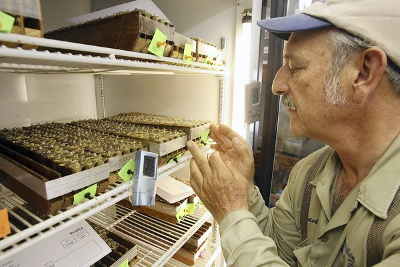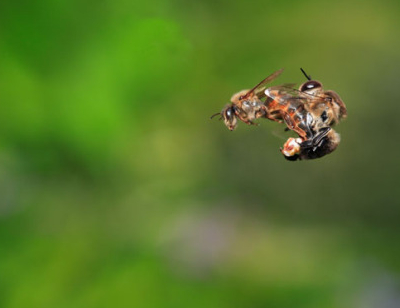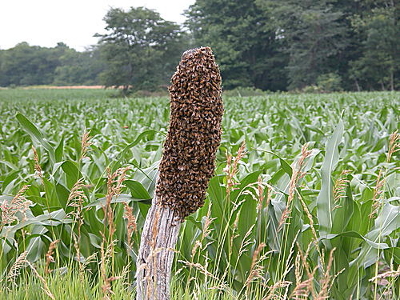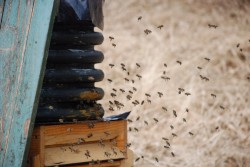
Natural vs. artificial bee reproduction
 Over the last three years,
I've gotten good at swarm
prevention, and even
splitting
hives to reproduce
them without buying new bees. However, David Heaf makes a good
argument for such manipulations being bad for bees and posits that our
honeybees would be healthier if we stayed closer to their natural
reproductive system.
Over the last three years,
I've gotten good at swarm
prevention, and even
splitting
hives to reproduce
them without buying new bees. However, David Heaf makes a good
argument for such manipulations being bad for bees and posits that our
honeybees would be healthier if we stayed closer to their natural
reproductive system.
Heaf explains that the
queens in commercially purchased hives are problematic for several
reasons. First, there's the issue of low genetic diversity since
most hives in the U.S. are the offspring of only 500 breeder
queens. There's a genetic bottleneck on the male side too since
traditional beekeepers believe in cutting out drone comb so the excess
males won't be a drain on the hive, and since some commercial
operations artificially inseminate their breeder queens.
 Since you probably didn't
learn about bee sex in high school, let me back up here. When a
queen bee matures in nature, she flies out of the hive to a drone
congregation area, where all of the male bees from the surrounding
region are hanging out and drinking beer...ahem, waiting for a queen to
appear. They fly after her and several drones will usually mate
with the queen (dying in the process). The queen stores all of
that sperm and uses it over the course of her life to fertilize
eggs. Despite the fact that there are plenty of drones in her
hive, the queen never mates again after having her youthful fling.
Since you probably didn't
learn about bee sex in high school, let me back up here. When a
queen bee matures in nature, she flies out of the hive to a drone
congregation area, where all of the male bees from the surrounding
region are hanging out and drinking beer...ahem, waiting for a queen to
appear. They fly after her and several drones will usually mate
with the queen (dying in the process). The queen stores all of
that sperm and uses it over the course of her life to fertilize
eggs. Despite the fact that there are plenty of drones in her
hive, the queen never mates again after having her youthful fling.
Multiply mated queens
seem to result in healthier hives, perhaps because the workers produced
by the queen are more genetically diverse. (Many of them are half
sisters, with different fathers who provided different traits to their
offpsring.) Perhaps that's why  workers prefer multiply
mated queens and may supersede a queen who wasn't
promiscuous enough during her Rumspringa.
workers prefer multiply
mated queens and may supersede a queen who wasn't
promiscuous enough during her Rumspringa.
Another issue with
mainstream beekeeping genetics is a lack of culling. When a
commercial operation raises bees, they keep all of the normal-looking
queens to send out to customers, but nature is much more
relentless. When a hive decides to swarm, the workers produce
several queens, but only 10% or so are allowed to survive and take over
the colony. Then there's another round of culling in the winter
when 80% of new swarms die in the wild. The result is that only
the toughest colonies survive, in stark contrast to our mainstream
beekeeping system that props up weak hives with chemicals and
feeding. True, we would lose lots of colonies if we simply
deleted the chemicals and culled weak hives, but we'd also slowly breed
for bees that are more self-sufficient and less prone to succumb to
disease.
 Which is all a long way of
explaining why David Heaf believes the potential of Warre hives to
swarm is a feature, not a bug. Letting the bees reproduce
naturally via swarming helps increase the genetic diversity of your
bees, while also culling weak hives before they start. You may
lose some bees to the surrounding area, but if you build bait hives,
you will capture some as well. Swarming cuts down on your honey
harvest for the year, but the theme of Warre beekeeping is healthy bees
not maximum honey yields.
Which is all a long way of
explaining why David Heaf believes the potential of Warre hives to
swarm is a feature, not a bug. Letting the bees reproduce
naturally via swarming helps increase the genetic diversity of your
bees, while also culling weak hives before they start. You may
lose some bees to the surrounding area, but if you build bait hives,
you will capture some as well. Swarming cuts down on your honey
harvest for the year, but the theme of Warre beekeeping is healthy bees
not maximum honey yields.
| This post is part of our Warre Hive lunchtime series.
Read all of the entries: |
Want more in-depth information? Browse through our books.
Or explore more posts by date or by subject.
About us: Anna Hess and Mark Hamilton spent over a decade living self-sufficiently in the mountains of Virginia before moving north to start over from scratch in the foothills of Ohio. They've experimented with permaculture, no-till gardening, trailersteading, home-based microbusinesses and much more, writing about their adventures in both blogs and books.
Want to be notified when new comments are posted on this page? Click on the RSS button after you add a comment to subscribe to the comment feed, or simply check the box beside "email replies to me" while writing your comment.
- Remove comment

- Remove comment
- Remove comment
- Remove comment
